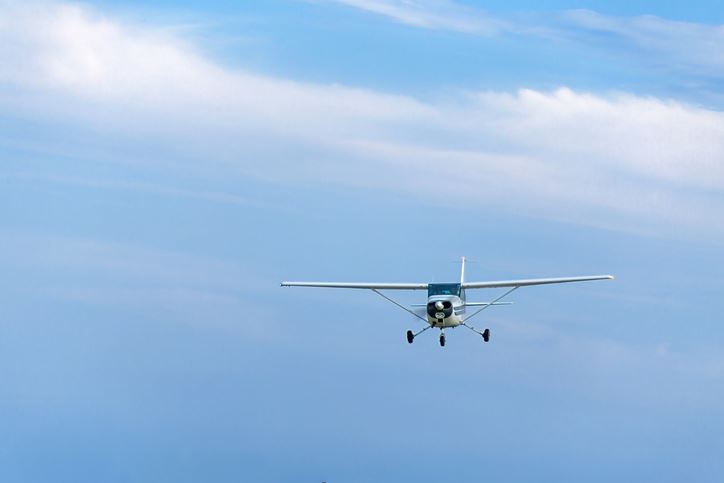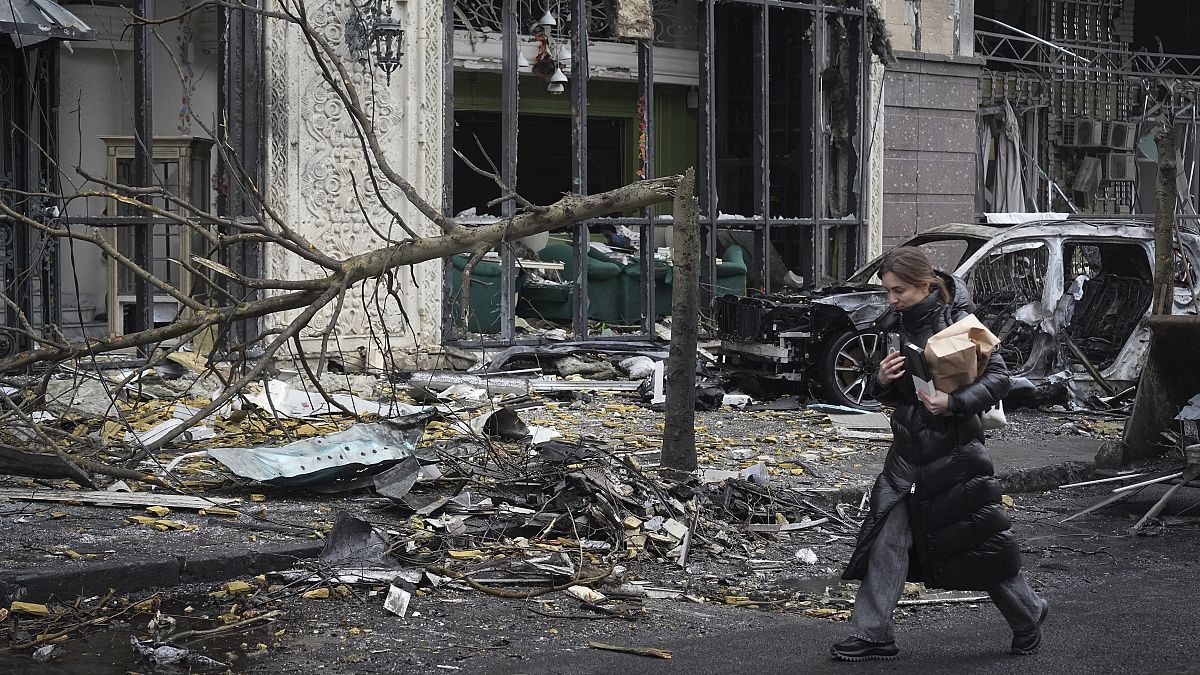North Dakota
Trinity blast in ‘Oppenheimer’ was start of tests that sent fallout clouds over Dakotas, Minnesota

FARGO — During the final seconds of the countdown, most of the observers in the New Mexico desert laid down with their feet toward a firing tower that rose 100 feet above the Alamogordo Bombing and Gunnery Range.
At 5:30 a.m. on July 16, 1945, the Manhattan Project’s Trinity atomic bomb detonated, unleashing a 19-kiloton explosion, melting asphalt and sand into green glass and sending radioactive material billowing 50,000 to 70,000 feet into the atmosphere.
The blast marked the beginning of the nuclear age — and the beginning of a decades-long era of atmospheric nuclear testing that deposited radioactive fallout throughout the United States and worldwide.
The thundering Trinity test — the climactic scene in the recently released movie “Oppenheimer” — showered fallout on 46 states, including North Dakota, Minnesota and South Dakota, within 10 days.
A study using state-of-the-art computer modeling drew upon newly available data sets to reach its findings and also computed cumulative deposits of radioactive fallout in the United States for the first five days after each of 93 atmospheric nuclear weapons tests at the Nevada Test.
The study, led by Princeton University researcher Sebastien Phillippe, is the latest to estimate cumulative fallout deposits from U.S. atmospheric nuclear tests.
“Our results demonstrate the significant impact of Trinity, the first nuclear weapon test, on the overall deposition density in New Mexico and across the contiguous U.S.,” the study authors wrote.
Despite their distance from the Nevada Test Site, fallout levels were notably high in North Dakota, Minnesota and South Dakota, leaving lingering questions about cancer and other health effects.
The Forum, in a special report published on May 1, 1988, investigated fallout exposure in the tri-state region, including some of the nation’s highest readings for radioactivity in milk in the Mandan area and wheat near Crookston, Minnesota
.
Fargo was cited as an example of a “hot spot,” an area of unusual fallout, in 1959 congressional hearings, The Forum reported. Radioactive debris in the soil increased more than tenfold from June to July 1957 after rains from fallout clouds.
The detonation of atomic and nuclear bombs at the Nevada Test Site were timed so that winds would carry the fallout away from population centers, including Las Vegas and Los Angeles.
That meant the fallout plumes, carried by winds in the upper atmosphere, often traveled to the north and east — toward the Dakotas and Minnesota.
Maps illustrating the study’s estimated fallout density show high concentration levels reached the western Dakotas, with more diffuse high levels to the east.
Not surprisingly, the highest fallout densities were clustered in the Southwest, including New Mexico, Utah and Nevada, and extended north to Colorado, Idaho and Wyoming, the study found.
Little has been done nationally to determine possible health effects from radioactive fallout from nuclear tests, despite the known link between radiation and cancer. The higher the dose, the greater risk of developing cancer over time.
A study in 1994 by the North Dakota Department of Health, spurred in part by The Forum’s special report, concluded that a “conservative estimate” of between 50 and 100 cases of thyroid cancer could have occurred because of radioactive fallout.
The study also determined three or four cases of childhood leukemia could have resulted from fallout and found North Dakota’s rise in the childhood leukemia death rate from 1963 to 1967 was “consistent with a radiation effect.”
“It’s something that’s been largely forgotten or completely forgotten,” said Dr. Stephen McDonough, who, as chief of the preventive health section, was the study’s lead author.
Although the study found elevated levels for certain cancers associated with radiation, it was not able to prove a causal link, he said.
“You can’t prove it, that the nuclear fallout killed children, but it’s certainly in the realm of possibility,” he said. “I did make a serious effort to look at it. I tried to be thorough.”
North Dakota’s milk had higher levels of radioactive Strontium-90 in milk than other areas of the country from 1955 to 1965. “As a result, North Dakotans were exposed to among the highest amounts of measured dietary Strontium-90 in the United States,” the study found.
A 1966 federal study estimated infants fed milk produced in the Fargo area after the July 1957 fallout episode received a significant dose of radioactive iodine, The Forum reported in 1988. The Fargo levels for one summer were comparable to those accumulated over four years by infants in a Utah fallout town.
Multiple myeloma, a form of cancer that has been associated with radiation, was elevated in Burleigh County, which includes Bismarck, from 1968 to 1987. “This elevated death rate is consistent with the delayed onset of non-leukemia tumors after radiation exposure,” the study said.
The study found that of 22 types of cancer, along with infant mortality, only childhood leukemia, thyroid cancer and multiple myeloma showed possible associations with fallout in North Dakota.
“Despite the heavier than average fallout, North Dakota was, and remains, a healthy place to live,” the study said.
A study in 1987 by the South Dakota Department of Health concluded there were 111 more leukemia deaths than expected, or 10%, from 1950 to 1969. Extrapolating from those additional leukemia deaths, the study calculated there could have been another 1,000 deaths from other cancers due to radioactive fallout plumes.
McDonough said the federal government has failed to adequately study possible cancers and other health effects throughout the United States as a result of its atmospheric nuclear testing program.
“The question is, does the U.S. government owe something to those who got thyroid cancer or whose child died from leukemia during that period,” he said.
Detonating nuclear weapons above ground sent radioactive materials as high as 50 miles into the atmosphere. Large particles fell to the ground near the blast site, but lighter particles and gases migrated into the upper atmosphere, according to the Environmental Protection Agency.
Hundreds of above-ground tests were conducted around the world from 1945 to 1963. Most atmospheric testing ended following an international treaty in 1963, including in the United States and the former Soviet Union, with the last above-ground nuclear test conducted in 1980, according to the EPA.
Fallout typically contains hundreds of radionuclides. Some persist for long periods, such as Cesium-137, which has a half life of about 30 years. Most have short half lives and decay away within minutes or hours. Iodine-131, associated with thyroid cancer, has a half-life of eight days.

North Dakota
Hebron woman killed in crash near Glen Ullin

MORTON COUNTY, N.D. (KFYR) – A Hebron woman was killed in a crash around 4:30 p.m. Friday on Morton County Road 88 just north of Glen Ullin.
The North Dakota Highway Patrol says the 66-year-old was distracted by a phone call, veered off the road into the ditch and hit a concrete bridge support.
The driver was not wearing a seatbelt and was life-flighted to a Bismarck hospital where she was pronounced dead.
Three children in the SUV were injured and transported to the hospital by ambulance. They were wearing seatbelts according to authorities.
Copyright 2024 KFYR. All rights reserved.
North Dakota
North Dakota’s John Hoeven, Kevin Cramer tout counter-UAS, mental health provisions in defense policy bill

GRAND FORKS — The latest defense authorization bill expands mental health care access for North Dakota’s military service members and adds new provisions for countering threats posed by unmanned drones.
Those are among the provisions touted by North Dakota’s two U.S. senators in the annual National Defense Authorization Act. President Joe Biden signed the bill into law Monday after it passed by divided votes in the House and Senate.
Language in the latest NDAA includes an order to establish a counter-UAS task force combatting drone incursions onto U.S. military bases and several provisions for current service members’ mental health care, including measures singling out pilots of U.S. combat drones.
Drone incursions have been reported in recent weeks over U.S. military bases in England and Germany, while residents of several eastern states have reported seeing numerous unidentified lighted drones flying overhead, though U.S. officials say most of the latter incidents have been manned aircraft.
Sen. John Hoeven, R-N.D., said the NDAA “helps formalize what (the Defense Department) is already doing” to combat unwanted drone use, citing the counter-UAS goals of
Project ULTRA
and ongoing efforts to
integrate drones into U.S. airspace at the Northern Plains UAS Test Site.
Project ULTRA — which stands for UAS logistics, traffic, research and autonomy — seeks to boost national security and operational efficiency of unmanned aerial system operations.
“The interesting thing about Grand Forks is we’ve built an ecosystem where, I’ve talked about us being the tip of the spear against China; we’re the tip of the spear in developing drone and counter-drone,” Hoeven said.
Sen. Kevin Cramer, R-N.D., has championed a provision that expands the number of mental health providers certified under military health insurance provider TRICARE.
Cramer said he pushed for the expanded access in response to a pair of suicides among Grand Forks Air Force Base personnel in the past several years.
“The standards to join TRICARE are so stringent now, they don’t take into account that some states like North Dakota only have certain accreditations and certifications that are available to them,” Cramer said. “If you don’t get the right credential — it’s not that it’s a better credential, just the right one — your providers don’t meet the standard for TRICARE.”
He’s also pushed for a provision creating a combat status identifier for pilots of remotely piloted aircraft involved in combat operations.
Cramer cited as inspiration the 119th Wing of the North Dakota National Guard, which flies MQ-9 Reaper unmanned planes.
“Our remote pilots are treated differently when it comes to things like PTSD potential or depression or mental health challenges as the result of, say, a kill shot,” he said. “I wanted to make sure the remote pilots are given the same type of consideration as somebody that’s in the cockpit of an airplane.”
This year’s NDAA also authorizes $1.9 million in planning and design funding for maintenance on Grand Forks Air Force Base’s runway —
one of Cramer’s pet projects
— and reauthorization for the Space Development Agency’s mission, including its recently-established Operations Center North at Grand Forks Air Force Base.
Hoeven said his office is working to appropriate another $450 million toward an advanced fire control system
built off the SDA’s network of low-Earth orbit satellites.
Other North Dakota-specific provisions in this year’s NDAA include authorization for funding to update the UH-72 Lakota helicopters used by the North Dakota National Guard and funding authorization to modernize Minot Air Force Base’s nuclear capabilities.
Policy measures, like more provider options for mental health care or the counter-UAS task force, became law with the passage of the NDAA.
However, NDAA provisions that require funding — like nuclear modernization or the runway study — will need to pass in a separate defense appropriations bill.
“An authorization just says that it’s approved,” Hoeven explained. “In defense appropriations, we allocate the dollars to do it, and if we don’t provide those dollars for the NDAA, for those authorizations or programs, then obviously they don’t advance.”
The federal government is currently operating at last year’s funding levels via a continuing resolution set to expire in March. Congress will have to attempt to pass a defense appropriations bill before then or pass another continuing resolution.
The NDAA usually passes with significant bipartisan support. This year, however, the bill passed with significant dissent from both House and Senate Democrats after a last-minute amendment by House Speaker Mike Johnson
added language barring TRICARE from covering some gender-affirming care
for transgender children of service members.
Both Hoeven and Cramer expressed support for Johnson’s amendment, which blocks gender-affirming care “that could result in sterilization” — though medical professionals say hormone therapy (like puberty blockers) generally does not cause infertility.
Cramer said providing gender-affirming care did not support military readiness and dismissed concerns about the mental health impact of denying that care to minors.
“(The amendment) has a much lower priority than caring for people who are stressed out by the fact that they’re a warfighter,” he said. “We need them to be healthy, we need them to be ready for war, and puberty blockers, gender-affirming care, just simply don’t do either of those things.”
Hoeven said gender-affirming care was hurting military readiness and recruiting and decried providing gender-affirming care as a “social experiment,” a phrase also used by Cramer.
President-elect Donald Trump is widely expected to reinstate a ban on transgender service members in the U.S. Armed Forces, as he did in his first administration.
North Dakota’s U.S. senators also dismissed concerns that the Johnson provision could affect bipartisanship or productivity in the next Congress.
The Senate ultimately passed the NDAA 85-15, while less than half of the House’s Democrats supported the act.
More Democrats attacked Johnson’s last-minute addition while saying they felt compelled to vote for the broader bill.
“I’m hopeful Democrats will come around and join us with what we’ve always done with our military, which is support our professional, great men and women in uniform who do such an outstanding job, not a bunch of social policies that shouldn’t be in there,” Hoeven said.
He also said he expects the embattled House speaker, who holds one of the smallest House majorities in history, to be reelected next year.
Cramer called this year’s NDAA a loss for the political left but said he “wouldn’t read a whole lot” into the dissent, pointing out the bill had continued its decades-long streak of passing into law despite partisan gridlock.
The 118th Congress, which ends Jan. 3, has been called one of the least productive Congresses in decades, and is by some counts the least productive in U.S. history.
North Dakota
Take a look at the most popular Life stories from the year

FARGO — The world of feature stories is always full of interesting and often quirky tales about some of the most unique people. Here’s a look at the stories our readers couldn’t get enough of this past year.
N.D. actor played Kathy Bates’ husband in “Matlock”
Contributed/CBS ©2024 CBS Broadcasting, Inc. All Rights Reserved.
Wahpeton, North Dakota, native Sam Anderson has starred in nearly 200 movies and television shows throughout his 50-year career and
his latest is alongside Oscar-winner Kathy Bates in the new “Matlock.”
Reporter Tracy Briggs caught up with Anderson earlier this fall while the show was airing on CBS, and he called the experience “a gift”.
The reboot of Andy Griffith’s legal drama (which ran from 1986-1995) reimagines Matlock with Bates in the titular role of Madeline “Matty” Matlock who is investigating the death of her daughter, whom she shares with her husband Edwin, played by Anderson.
“I love what it says about women, particularly older women, and it’s funny and heart-wrenching. It really makes you think and gets you in the heart, and that’s my favorite kind of work,” Anderson said.
Jeffrey Fonder remembered as the face of Dempsey’s

Contributed / Ben Hoos
In August, the unofficial greeter of Dempsey’s Public House died and the community outpouring for
Jeffrey Fonder, who’d worked at a downtown staple since 2006, remembered him
as someone who “made everyone feel like family”, according to longtime regular Dan Haglund. Fonder, who eventually became general manager after started as a bartender, won Best Bartender in the High Plains Reader’s Best Of poll multiple times. When he wasn’t greeting customers, Fonder helped book bands and often enjoyed the music himself from either behind the bar or in front of the stage, reporter John Lamb wrote.
North Dakota queens crowned

Contributed
In May,
two North Dakota women were crowned
during the annual competition in Watertown, South Dakota. Codi Miller, 31, of Mandan was selected as Miss North Dakota, and Jaycee Parker, 17, of Minot AFB was selected as Miss North Dakota Teen. Both advanced to the national pageants that were held in August.
Fargo restaurateurs, chef and bakery nominated for James Beard Awards

Forum file photo
Fargo’s food scene earned several nods at the beginning of
2024 as semifinalists for James Beard Awards,
one of the highest honors in the American food industry. Business partners
Nikki Ness Berglund and Ryan Nitschke,
who run
several area eateries,
made the list as Outstanding Restauranteur while
Nichole’s Fine Pastry & Café
was nominated for Outstanding Bakery in the country, reporter John Lamb wrote. Additionally,
Andrea Baumgardner
, owner of the
now-closed BernBaum’s,
was nominated for Best Chef Midwest, a region that includes North Dakota, South Dakota, Minnesota, Iowa, Missouri, Kansas, Nebraska and Wisconsin. While none of the local nominees went on to win their respective categories, their nominations illustrate just how notable the local culinary culture is becoming.
Moorhead artist transforms bungalow into charming gem

Alyssa Goelzer / The Forum
Moorhead artist and former educator Lana Suomala
has experienced a lot of life changes recently, one of which was the completion of a renovation that turned her 100-year-old bungalow into a bright and charming gem on a sleepy half-street in Moorhead. When she purchased it, the home lacked necessary updates and reeked of cat urine, reporter Tammy Swift wrote, but she enlisted contractors and put plenty of sweat equity into the home to showcase its beautiful features like sweeping arches and natural maple floors.
The result is a lovely little home
where Suomala can continue reinventing herself and inspiring others along the way.
Secrets to growing a show-stopping clematis vine

Britta Trygstad / Special to The Forum
Don Kinzler has been sharing incredible gardening knowledge in his Growing Together and Fielding Questions columns since March 2013, and readers love it.
This July column about about clematis, “the queen of flowering vines”, according to Kinzler,
was a hit with readers. In his conversational style, Kinzler shared important tips for growing this show-stopping perennial vine.
Minnesota man buys vintage ‘Woodie Wagon’

Chris Flynn / The Forum
In July, reporter Robin Huebner shared a story about a
1940 “Woodie Wagon” that once belonged to actress Bette Davis now owned by Glyndon couple Gary and Kari Myhre.
The vehicle — named for its wood body — was shown in Davis’ movie “Now, Voyager” and was last owned by an investment company employee whose possessions were repossessed after he was caught up in a Ponzi scheme and went to prison, Huebner wrote. When Davis drove the car, wooden blocks were added under the bench seat so the actress could see over the wheel. The car is one of only about 500 made, and Gary Myhre said a registry compiled more than 25 years ago indicated only about a dozen still remaining, including his in Glyndon.
Billionaire donates millions to nonprofits across Dakotas, Minnesota

REUTERS / Danny Moloshok
In March, the
former wife of Amazon founder Jeff Bezos MacKenzie Scott made headlines in the Midwest
when she handed out $640 million to various nonprofits throughout the country, including several in North Dakota and Minnesota.
Local recipients included Youthworks, which received $1 million to continue its work of providing youth with shelter and development opportunities; SAGE Development Authority on the Standing Rock Reservation, which received $2 million to fund renewable and sustainable energy practices; and Gender Justice, which received $2 million for its work in North Dakota, Minnesota and South Dakota to advance gender equity through the law.
Danielle Teigen has a bachelor’s degree in journalism and management communication as well as a master’s degree in mass communication from North Dakota State University. She has worked for Forum Communications since May 2015 and is the author of two non-fiction history books.
-
/cdn.vox-cdn.com/uploads/chorus_asset/file/24924653/236780_Google_AntiTrust_Trial_Custom_Art_CVirginia__0003_1.png)
/cdn.vox-cdn.com/uploads/chorus_asset/file/24924653/236780_Google_AntiTrust_Trial_Custom_Art_CVirginia__0003_1.png) Technology1 week ago
Technology1 week agoGoogle’s counteroffer to the government trying to break it up is unbundling Android apps
-

 News1 week ago
News1 week agoNovo Nordisk shares tumble as weight-loss drug trial data disappoints
-

 Politics1 week ago
Politics1 week agoIllegal immigrant sexually abused child in the U.S. after being removed from the country five times
-

 Entertainment1 week ago
Entertainment1 week ago'It's a little holiday gift': Inside the Weeknd's free Santa Monica show for his biggest fans
-

 Lifestyle1 week ago
Lifestyle1 week agoThink you can't dance? Get up and try these tips in our comic. We dare you!
-
/cdn.vox-cdn.com/uploads/chorus_asset/file/25672934/Metaphor_Key_Art_Horizontal.png)
/cdn.vox-cdn.com/uploads/chorus_asset/file/25672934/Metaphor_Key_Art_Horizontal.png) Technology4 days ago
Technology4 days agoThere’s a reason Metaphor: ReFantanzio’s battle music sounds as cool as it does
-

 Technology1 week ago
Technology1 week agoFox News AI Newsletter: OpenAI responds to Elon Musk's lawsuit
-

 News5 days ago
News5 days agoFrance’s new premier selects Eric Lombard as finance minister




















